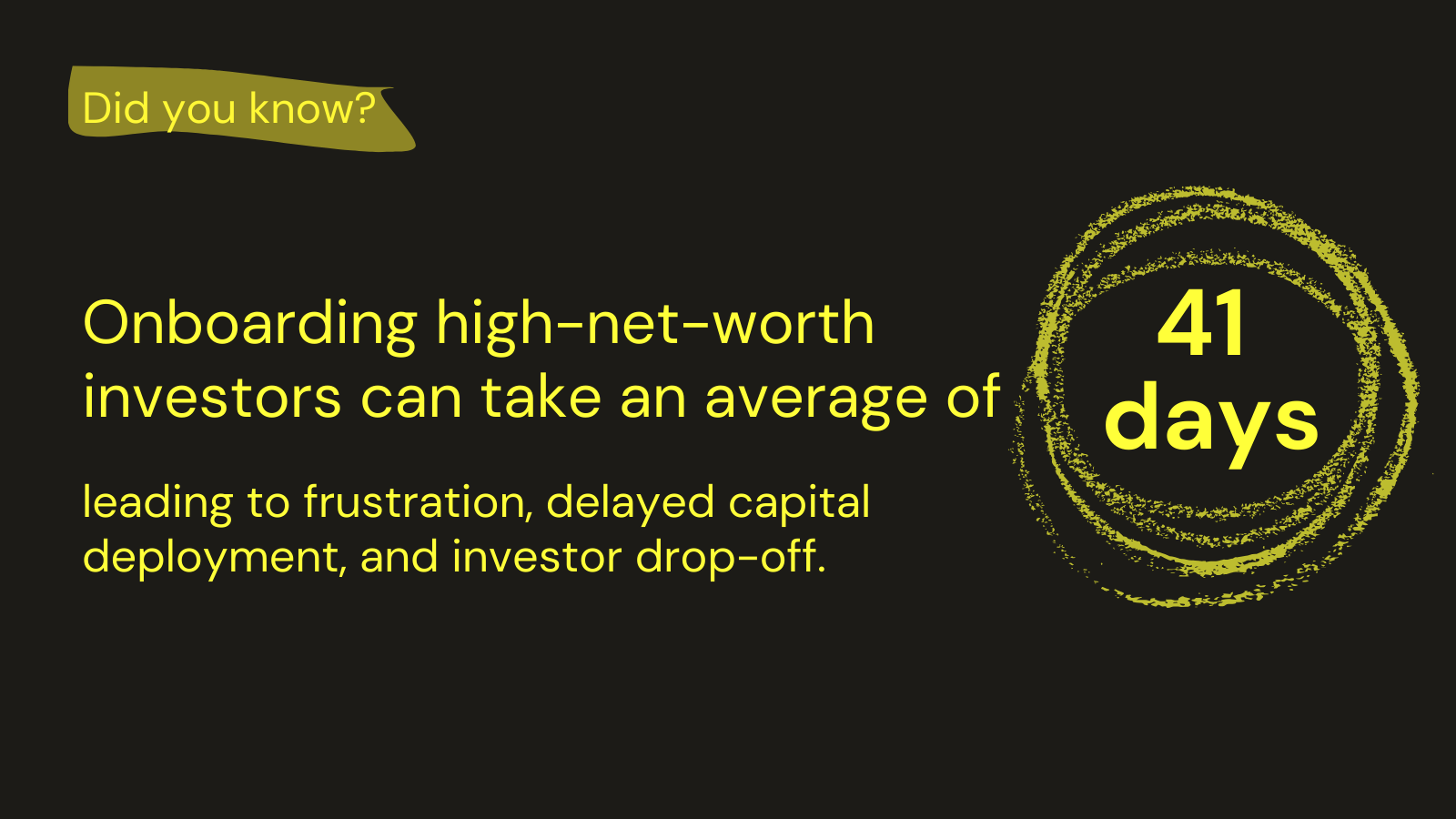Investor Onboarding That Actually Works: The Automation Edge
Last Revised: September 8, 2025At a Glance
- Manual investor onboarding is slow, error-prone, and expensive — AML/KYC alone consumes nearly 20% of onboarding time.
- Inefficient processes have consequences: onboarding high-net-worth investors takes ~41 days, leading to frustration, delayed capital deployment, and drop-off.
- Automation enables faster onboarding, reduces friction for investors, and helps firms stay compliant without adding headcount.
Efficient investor onboarding sets the tone for a lasting relationship. Today’s investors expect more than just paperwork completed correctly — they want a smooth, efficient process that minimizes friction from the start. Slow, manual onboarding creates frustration, delays capital deployment, and leaves a poor first impression. Automated KYC and AML workflows make the difference, enabling fund managers to deliver a faster, more transparent experience without adding operational burden.
From Subscription to Capital Call: A Seamless Investor Journey
KYC automation transforms the investor onboarding journey — from the initial subscription process through to approval and readiness for capital calls. Instead of a fragmented process with repeated document requests, investors experience a smoother path where information is validated quickly and securely in the background. According to an EY survey, AML and KYC processes alone can account for nearly 20% of total onboarding time, highlighting the significance of efficiency gains in this stage of the journey.
Forward-looking fund managers are already using automation to cut onboarding times dramatically. What once took weeks of back-and-forth can now be completed in days, with smart systems automatically validating IDs, checking sanctions lists, and routing investors through appropriate paths, making for a frictionless experience for investors and a more efficient process for the firm.
Risk-Based Due Diligence: Smarter, Faster, Friction-Free
Leading private market firms are adopting risk-based due diligence, which applies the right level of KYC and AML checks depending on investor profile. Every investor still undergoes baseline verification, but enhanced scrutiny is reserved for higher-risk cases — such as politically exposed persons (PEPs), investors in high-risk jurisdictions, or complex ownership structures. This ensures rigor where it’s most needed, while reducing friction for low-risk investors.
The impact on investor experience is significant. Manual, one-size-fits-all processes often drag onboarding out far longer than investors are willing to tolerate. In fact, a Kofax study found that onboarding high-net-worth investors can take an average of 41 days, leading to frustration, delayed capital deployment, and in some cases investor drop-off.
By automating risk-based due diligence, fund managers can streamline workflows for the majority of investors, while still escalating higher-risk cases for deeper review. The result: faster onboarding, fewer manual bottlenecks, and a more investor-friendly experience.

Onboarding high-net-worth investors can take an average of 41 days.
Data Integration: Breaking Down Silos
Effective KYC automation depends on seamless data flow across fund operations. Too often, compliance teams, investor relations, and fund administrators work from different systems, forcing repeated data entry and manual reconciliations.
By integrating onboarding workflows with fund accounting platforms, investor portals, and document repositories, firms create a single source of truth for investor data. This reduces errors, accelerates compliance approvals, and provides a clear audit trail for both internal teams and external auditors.
The result is a smoother, more efficient investor onboarding process that minimizes back-and-forth requests, ensures consistency across teams, and saves weeks of operational effort.
Overcoming Implementation Hurdles
Implementing KYC automation is not as simple as flipping a switch. In private markets, onboarding spans multiple jurisdictions, investor types, and legacy systems — making integration and change management a real challenge. Many solutions sound straightforward in vendor brochures, but the reality on the ground is more complex.
Drawing on conversations with compliance and operations professionals, this section highlights the most common hurdles firms face; and offers practical strategies for overcoming them to unlock the full benefits of automation.
Integrating With Legacy Systems: Bridging the Gap
One of the biggest hurdles in implementing KYC automation is integration with legacy fund systems. Many fund managers and administrators still rely on traditional platforms that may be powerful for fund accounting, but are not built for digital onboarding. The result is duplicate data entry, siloed investor records, and limited transparency across teams.
The solution lies in careful integration planning. Modern platforms should offer API connectivity to sync with existing systems, ensuring investor data flows seamlessly between compliance, operations, and other relevant teams. Where APIs aren’t available, firms may need custom connectors or phased migration strategies. Addressing these gaps upfront is essential for realizing the full benefits of automation without disrupting core operations.

Automated invstor onboarding: Integrating with legacy systems
Transitioning Your Team: Managing Change Effectively
Moving from manual KYC processes to automated workflows requires thoughtful change management. Many compliance and operations teams are deeply accustomed to spreadsheets, email-based document collection, and manual checklists. Introducing automation can feel disruptive, mostly due to uncertainty around trusting the system and re-mapping established workflows.
The key is to involve your team from the outset. Explain how automation reduces repetitive tasks, improves auditability, and frees them to focus on higher-value reviews. Provide structured training, run pilot cases, and address concerns proactively. By showing the system working in practice and demonstrating how it handles exceptions, you build the trust needed for smooth adoption.
Navigating Regulatory Complexities: Adopting Flexible Solutions
KYC and AML requirements vary significantly across jurisdictions. A process that meets standards in Luxembourg may not satisfy Cayman or U.S. requirements. For global managers and their administrators, this creates a major challenge: how to maintain consistency without falling into endless jurisdiction-specific manual work.
The answer isn’t building technology in-house — it’s adopting a flexible platform that can adapt to evolving rules. Configurable workflows and modular design allow compliance teams to tailor onboarding steps by jurisdiction, investor type, or risk profile. This flexibility ensures ongoing compliance, reduces manual exceptions, and avoids costly rework as regulations change.
Handling Exceptions and Edge Cases: Refining the Automation
Automated systems excel at handling standard KYC checks but can face challenges with exceptions and edge cases. In private markets, these often include investors with dual citizenship, complex trust or corporate ownership structures, or names that generate repeated false positives in sanctions screening. These scenarios still require human intervention and careful refinement of automated rules.
Over time, automation platforms can learn from these cases, improving pattern recognition and reducing unnecessary alerts. While full “set-and-forget” automation isn’t realistic, continuous refinement ensures that exceptions become less disruptive and compliance teams can focus on genuine risks rather than clearing false positives.

Continuously refining automation
Realistic Timelines for Implementation: Setting Achievable Goals
Implementing KYC automation takes time. While many vendors promise rapid deployment, the reality in private markets is more complex. Integrating with legacy fund systems, training staff, and refining automation rules all require careful planning.
Setting realistic timelines is essential for managing expectations and ensuring success. No firm can automate everything overnight. The most effective approach is phased: start with a pilot, refine the workflows, and expand gradually. This minimizes disruption and allows teams to adapt with confidence.
That said, not all platforms are equal. Solutions like Blackbird, purpose-built for private markets with configurable workflows and AI-first integrations — can cut implementation times significantly without compromising compliance. The result is faster time-to-value, reduced operational drag, and a smoother onboarding experience for investors.
The Bottom Line
Investor onboarding is no longer just paperwork — it’s a competitive differentiator. Firms that cling to manual KYC and fragmented workflows face frustrated investors, higher costs, and slower capital deployment. Those that embrace automation, however, gain efficiency, stronger compliance, and a far better investor experience.
Why Blackbird?
Blackbird offers an AI-first solution tailored to private market firms — covering KYC, AML, and Due Diligence in one seamless platform. Our built-in automation means faster onboarding and compliance, without the added headcount.
Want to see it in action? Book a demo with our team.
For more insights (or fun KYC memes), follow us on LinkedIn.
About the Author
Linoy Doron is a Content Strategist at Blackbird, where she translates complex fintech and compliance topics into clear, actionable insights. With a strong background in technology, SaaS, and UX, she crafts narratives that connect product value to the real needs of asset managers in the private market.